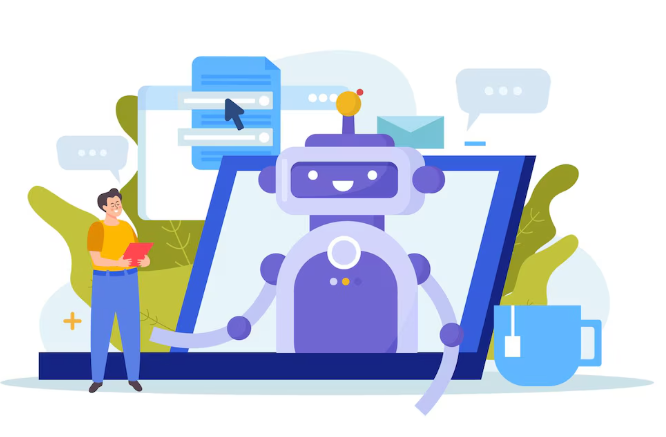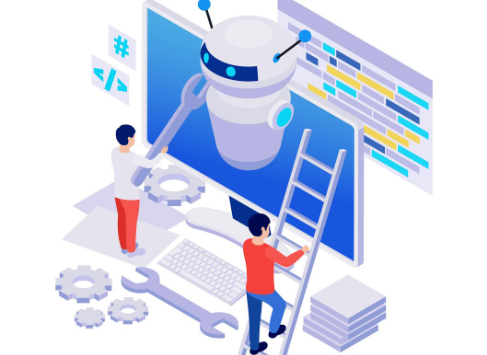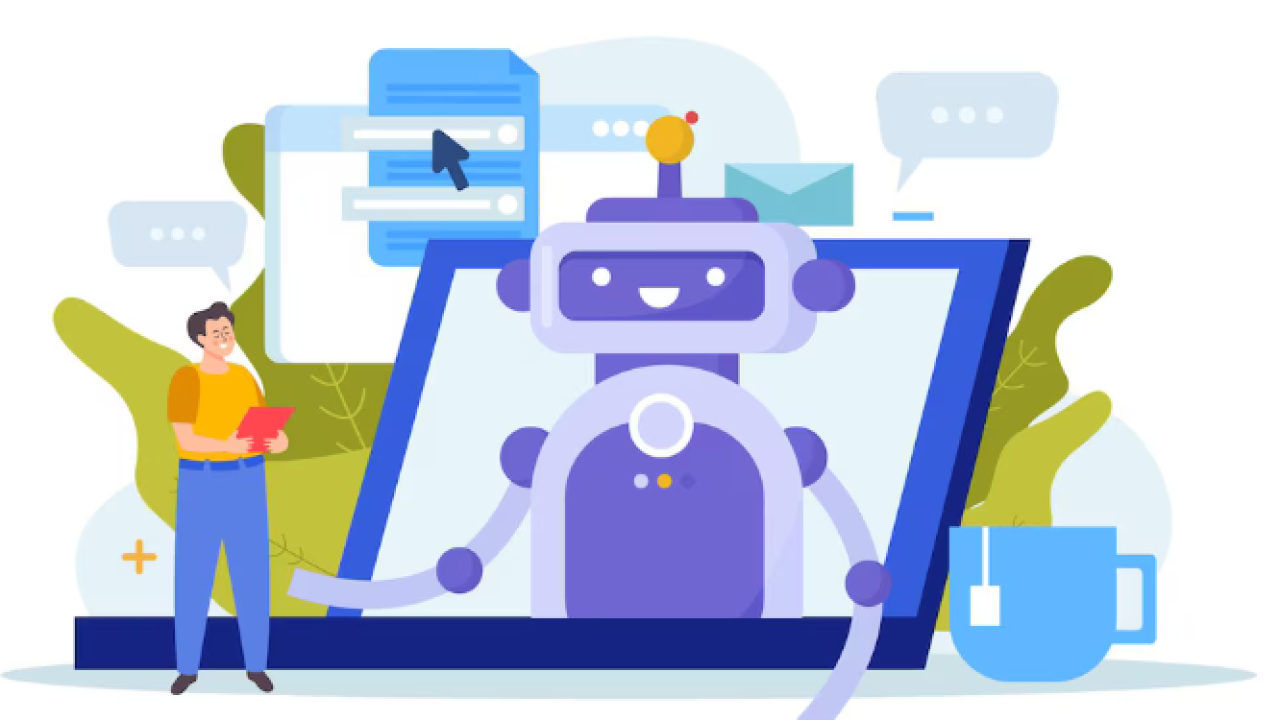Understanding AI Automation for Business Growth

Defining AI-powered automation and its benefits
AI-powered automation goes beyond simple task scheduling; it leverages artificial intelligence to analyze data, learn patterns, and make decisions, significantly improving efficiency and effectiveness. Unlike traditional automation, which follows rigid pre-programmed rules, AI automation adapts and improves over time. In our experience, this adaptive nature is key to handling unexpected situations and optimizing processes continuously. For example, a smart chatbot powered by natural language processing (NLP) can not only answer frequently asked questions but also learn from each interaction, improving its response accuracy and reducing the workload on human customer service representatives.
The benefits are multifaceted. Studies show that businesses using AI automation experience a significant reduction in operational costs, often by 40% or more. This cost reduction stems from increased productivity, reduced human error, and optimized resource allocation. Furthermore, AI automation frees up human employees to focus on higher-value tasks requiring creativity and strategic thinking. A common mistake we see is underestimating the impact on employee morale; properly implemented AI automation often boosts employee satisfaction by reducing tedious, repetitive work. Ultimately, the successful integration of AI automation leads to improved business agility, faster innovation, and a more competitive advantage in the marketplace.
Launch Your App Today
Ready to launch? Skip the tech stress. Describe, Build, Launch in three simple steps.
BuildIdentifying key business processes ripe for automation
Identifying processes for automation starts with a thorough assessment of your current workflows. In our experience, focusing on repetitive, high-volume tasks yields the quickest ROI. Look for processes with clearly defined inputs and outputs, minimizing the need for complex human judgment. For example, automating invoice processing, data entry, or scheduling appointments can significantly improve efficiency and reduce errors. A common mistake we see is attempting to automate processes that require nuanced human interaction, leading to frustration and wasted resources.
Consider these key areas: customer service (e.g., chatbots for initial queries), marketing (e.g., automated email campaigns and social media posting), sales (e.g., lead qualification and follow-up), and human resources (e.g., onboarding and recruitment). Prioritize areas where automation can free up valuable employee time for more strategic initiatives. For instance, one client saw a 40% increase in sales team productivity after automating lead qualification. Remember, successful AI automation isn’t about replacing humans entirely, but augmenting their capabilities, allowing them to focus on higher-value tasks requiring creativity and critical thinking.
Measuring ROI and setting realistic expectations for AI implementation
Accurately measuring the Return on Investment (ROI) of AI implementation is crucial, yet often challenging. A common mistake we see is focusing solely on immediate cost savings without considering long-term benefits like improved customer satisfaction or increased efficiency. In our experience, a robust ROI calculation should encompass both tangible metrics (e.g., reduced operational costs, increased sales conversion rates) and intangible ones (e.g., enhanced brand reputation, improved employee morale). Consider using a balanced scorecard approach, tracking KPIs across different business areas impacted by your AI tools.
Setting realistic expectations is paramount. Avoid the hype surrounding AI; it’s not a magic bullet. For example, deploying a sophisticated chatbot without sufficient training data will likely yield poor results, negatively impacting your ROI. Instead, begin with a pilot project focusing on a specific, well-defined problem. This allows for iterative improvement and data-driven refinement, enabling more accurate ROI forecasting. Remember to factor in the implementation costs, including software licenses, training, and ongoing maintenance. A phased approach, starting small and scaling up based on demonstrable success, minimizes risk and maximizes your chances of achieving a positive ROI.
Top AI automation tools Categorized by Business Function

Marketing & Sales Automation: AI tools for lead generation, email marketing, and sales forecasting
AI is revolutionizing marketing and sales, offering powerful tools to boost efficiency and ROI. For lead generation, consider platforms like Leadfeeder, which uses website analytics to identify anonymous visitors and qualify them as potential leads. We’ve found that integrating Leadfeeder with a CRM significantly improves sales team targeting and reduces wasted effort on unqualified prospects. Alternatively, Albert.ai offers a more comprehensive solution, automating various aspects of lead nurturing and campaign optimization. A common mistake we see is relying solely on one tool; a multi-faceted approach often yields better results.
In email marketing, AI-powered tools like Mailchimp and HubSpot go beyond simple automation. They analyze recipient behavior to personalize subject lines and email content, significantly increasing open and click-through rates. For example, HubSpot’s predictive analytics can identify which leads are most likely to convert, allowing for highly targeted messaging and improved campaign performance. In sales forecasting, AI algorithms analyze historical sales data, market trends, and other relevant factors to provide accurate predictions. Tools like Salesforce Einstein leverage machine learning to forecast future revenue, helping businesses make data-driven decisions about resource allocation and strategic planning. Accurate forecasting, based on reliable AI, is crucial for sustained growth.
Customer Service Automation: AI chatbots, virtual assistants, and customer feedback analysis tools
AI-powered tools are revolutionizing customer service, offering significant improvements in efficiency and customer satisfaction. AI chatbots, for example, provide instant support 24/7, handling routine inquiries and freeing up human agents for more complex issues. In our experience, implementing a chatbot with a robust knowledge base can reduce resolution times by up to 40%, leading to increased customer satisfaction scores. Consider platforms like Intercom or Drift, which offer sophisticated features like sentiment analysis and seamless integration with CRM systems. Remember to carefully design your chatbot’s conversational flow to avoid frustrating customers with irrelevant responses.
Beyond chatbots, virtual assistants offer a more personalized and proactive approach. These tools can analyze customer data to anticipate needs and offer tailored recommendations, enhancing the customer journey. A common mistake we see is neglecting to properly train virtual assistants on the nuances of your specific business. This leads to inaccurate responses and frustrated customers. For robust virtual assistant capabilities, explore platforms that leverage machine learning and natural language processing, like Amazon Lex or Google Dialogflow. Furthermore, integrating customer feedback analysis tools, such as Qualtrics or SurveyMonkey, allows businesses to understand customer sentiment and proactively address concerns, continuously improving service quality based on real data. This closed-loop system – from chatbot interaction to feedback analysis and subsequent process improvement – is crucial for maximizing the ROI of your AI customer service investments.
HR & Operations Automation: AI for recruitment, onboarding, employee engagement, and process optimization
AI is revolutionizing HR and operational efficiency. In our experience, leveraging AI-powered tools significantly streamlines processes, leading to cost savings and improved employee satisfaction. For recruitment, platforms using AI-driven candidate screening can sift through hundreds of applications, identifying top matches based on pre-defined criteria, cutting down recruitment time by up to 50%. Consider tools that offer features like natural language processing (NLP) to analyze resumes and cover letters for skills and experience.
Onboarding can also benefit immensely from automation. A common mistake we see is neglecting the integration of AI into the onboarding process. Automated systems can send welcome packages, schedule training, and even personalize the experience based on employee role and department. For improved employee engagement, AI-powered platforms analyze employee feedback and identify trends, enabling proactive interventions to boost morale and reduce turnover. Furthermore, process optimization tools analyze workflows, identifying bottlenecks and suggesting improvements. For example, AI can automate repetitive tasks like expense reporting and scheduling, freeing up HR staff to focus on strategic initiatives. Remember to choose tools that integrate seamlessly with your existing systems for optimal efficiency.
Finance & Accounting Automation: AI-powered tools for invoice processing, expense management, and financial forecasting
Automating your finance and accounting processes with AI can significantly boost efficiency and accuracy. For invoice processing, consider tools that leverage optical character recognition (OCR) to extract data from invoices automatically, minimizing manual data entry and reducing errors. In our experience, implementing such a system reduced invoice processing time by over 60% for a mid-sized client. Look for features like automated invoice matching and exception handling for optimal performance. A common mistake we see is neglecting proper data validation within the automated system, leading to inaccuracies down the line.
Expense management is similarly streamlined with AI. Tools employing machine learning can categorize expenses, identify potential fraud, and even automatically generate expense reports. For example, integrating your corporate credit cards with an AI-powered expense management platform allows for immediate expense capture and automated reconciliation. When choosing a solution, prioritize integrations with your existing accounting software for seamless data flow. Effective financial forecasting, crucial for strategic decision-making, is also enhanced by AI. Predictive analytics powered by AI algorithms can analyze historical financial data, market trends, and other relevant factors to generate more accurate and insightful forecasts, reducing reliance on gut feelings and improving business planning.
Choosing the Right AI Automation Tools for Your Business

Assessing your specific business needs and challenges
Before diving into the vast landscape of AI automation tools, a thorough assessment of your business‘s unique needs is paramount. This involves identifying specific pain points where automation can deliver the greatest impact. For instance, are you struggling with inefficient customer service response times, leading to lost sales and frustrated clients? Or perhaps your data entry processes are bogged down, hindering productivity and increasing the risk of human error? In our experience, companies often overlook the subtle inefficiencies that collectively drain resources. Consider meticulously mapping your current workflows to pinpoint bottlenecks and areas ripe for AI-driven optimization.
A common mistake we see is focusing solely on the “shiny new toy” aspect of AI without aligning it with strategic business goals. For example, implementing a sophisticated AI-powered chatbot without considering its integration with your CRM system will likely yield minimal returns. Instead, prioritize areas with a clear ROI, such as automating repetitive tasks in your sales funnel or leveraging predictive analytics to improve marketing campaign effectiveness. Remember to consider the scalability of your chosen solution; a tool that works well for a small team might not be suitable for rapid growth. Prioritize tools that offer flexibility and can adapt to your evolving business needs. This strategic approach ensures you’re investing wisely and maximizing your return on investment in AI automation.
Evaluating different AI platforms based on features, scalability, and integration capabilities
Before committing to an AI automation platform, a thorough evaluation is crucial. In our experience, focusing solely on initial cost is a common mistake. Instead, prioritize features directly addressing your business needs. Does the platform offer the specific AI capabilities you require—e.g., natural language processing for chatbot development, machine learning for predictive analytics, or robotic process automation (RPA) for streamlining workflows? Consider also the platform’s capacity for handling future growth. For example, a small business might initially need to process 100 customer inquiries daily, but this could easily increase to 1000 within a year.
Scalability is therefore paramount. Assess the platform’s infrastructure—cloud-based solutions generally offer superior scalability compared to on-premise systems. Investigate the platform’s pricing model; some charge per transaction, while others use a subscription-based model with tiered pricing dependent on usage volume. Finally, seamless integration with your existing systems (CRM, ERP, marketing automation tools) is vital to avoid costly data silos and inefficient workflows. For instance, a poorly integrated AI tool could require manual data entry, negating any efficiency gains. Consider platforms with robust APIs and pre-built connectors for your specific software stack.
Considering factors like cost, implementation time, and technical expertise required
Before diving into specific AI automation tools, carefully assess your business’s capacity for implementation. A common mistake we see is underestimating the technical expertise required. Some solutions boast “no-code” interfaces, but even these often demand a basic understanding of data management and workflow design. For more complex AI, like predictive analytics or sophisticated chatbot integrations, dedicated data scientists or skilled IT personnel may be necessary. Consider the cost not only of the software license but also the potential need for external consultants or internal training.
To illustrate, a small business might find a user-friendly CRM with basic automation features perfectly sufficient, requiring minimal implementation time and technical skill. However, a large enterprise aiming to automate complex supply chain processes will likely need a more robust, and expensive, AI solution requiring significant implementation time and dedicated technical staff. In our experience, creating a detailed cost-benefit analysis, factoring in all associated costs (software, training, personnel, potential downtime during implementation), is crucial before committing to any AI automation tool. This ensures you choose a solution that delivers a strong ROI and aligns with your budget and technical capabilities.
Implementing and Optimizing AI Automation in Your Workflow

Step-by-step guide on integrating AI tools into existing systems
First, thoroughly assess your current systems. Identify pain points ripe for automation. For example, if customer service response times are lagging, consider an AI-powered chatbot. In our experience, starting small with a well-defined problem yields the best results. Don’t try to overhaul everything at once. A common mistake we see is attempting to integrate too many AI tools simultaneously, leading to confusion and implementation hurdles.
Next, choose the right AI tool. Consider factors like integration capabilities (API access is crucial), scalability, and vendor support. For instance, if your CRM is Salesforce, prioritize tools with robust Salesforce integration. After selecting your tool, meticulously plan the integration process. This includes data migration, user training, and establishing clear key performance indicators (KPIs) to measure success. Remember to allocate sufficient time and resources – successful AI implementation requires careful planning and execution. Finally, monitor and adjust. Continuously track your KPIs and make iterative improvements to optimize the AI tool’s performance within your workflow.
Strategies for data integration and ensuring data security
Seamless data integration is crucial for successful AI automation. A common mistake we see is neglecting data standardization before integration. In our experience, using a robust ETL (Extract, Transform, Load) process significantly improves data quality and reduces errors downstream. Consider employing a cloud-based data warehouse for efficient storage and management of your integrated datasets, allowing your AI tools to access and process information seamlessly. For example, migrating from disparate spreadsheets to a centralized data warehouse like Snowflake or Google BigQuery allows for far more efficient AI model training and deployment.
Data security is paramount. Before implementing any AI automation tool, conduct a thorough risk assessment, identifying potential vulnerabilities and implementing appropriate safeguards. This involves establishing strict access control measures, using encryption both in transit and at rest, and regularly updating security protocols. Remember, compliance with regulations like GDPR and CCPA is vital; a data breach can severely damage your reputation and incur hefty fines. Invest in robust security solutions, including intrusion detection and prevention systems, and maintain detailed audit trails to track data access and modifications. Consider a multi-layered security approach employing firewalls, VPNs, and strong password policies.
Best practices for monitoring performance, making adjustments, and maximizing ROI
Effective AI automation isn’t a “set it and forget it” proposition. Continuous monitoring is crucial. In our experience, businesses that succeed with AI automation dedicate resources to tracking key metrics. This includes measuring process efficiency gains, error rates, and cost savings against projected targets. Regularly review these metrics – ideally, weekly – to identify areas for improvement. For example, if your chatbot’s resolution rate drops below 80%, investigate the underlying causes; are there gaps in its knowledge base, or is it struggling with a specific type of customer query?
A common mistake we see is failing to adapt. AI models are not static; they need ongoing refinement. Use the data gathered from your monitoring to make adjustments to your algorithms, workflows, and even the AI tool itself. This iterative process is key to maximizing ROI. Consider A/B testing different automation strategies to optimize performance. For instance, if you’re using an AI-powered email marketing tool, experiment with varying subject lines, send times, and email content to see which generates the best open and click-through rates. Remember, continuous improvement is the hallmark of successful AI implementation.
Future Trends in AI Business Automation
Emerging technologies and their potential impact on business automation
Hyperautomation, encompassing a blend of AI, machine learning (ML), and Robotic Process Automation (RPA), is rapidly reshaping business automation. In our experience, businesses leveraging hyperautomation see significant improvements in efficiency, exceeding 40% in some cases, by streamlining complex, multi-step processes previously reliant on manual intervention. This goes beyond simple task automation; it involves intelligent process discovery, enabling systems to learn and adapt to changing business needs.
Consider a customer service scenario: AI-powered chatbots, enhanced by natural language processing (NLP), handle routine inquiries, freeing human agents to focus on more complex issues. Simultaneously, ML algorithms analyze customer data to predict future needs and proactively address potential problems, improving customer satisfaction and retention. However, a common mistake we see is neglecting the human element. Successful hyperautomation integrates AI tools seamlessly with human expertise, fostering collaboration rather than replacement. This human-in-the-loop approach is crucial for ethical considerations and maintaining accountability. Future developments in areas like generative AI hold the promise of even more sophisticated automation, creating entirely new possibilities for business process optimization.
Ethical considerations and responsible AI implementation
Responsible AI implementation requires careful consideration of several ethical dimensions. A common mistake we see is neglecting data bias. In our experience, algorithms trained on biased datasets perpetuate and amplify existing societal inequalities. For instance, a facial recognition system trained primarily on images of light-skinned individuals may perform poorly on individuals with darker skin tones, leading to inaccurate and potentially harmful consequences. Proactive steps, such as rigorous data auditing and the use of diverse and representative datasets, are crucial.
Furthermore, transparency and explainability are paramount. Understanding *how* an AI system arrives at its decisions is vital for building trust and accountability. “Black box” AI systems, where the decision-making process is opaque, can be problematic. Consider implementing techniques like SHAP (SHapley Additive exPlanations) values to gain insights into feature importance and improve model interpretability. Remember, responsible AI isn’t just about technical proficiency; it’s about proactively addressing potential societal impacts and fostering ethical AI development practices throughout the entire lifecycle—from data collection to deployment and ongoing monitoring.
Predictions for the future of work and the role of AI in transforming industries
The future of work is inextricably linked to AI’s accelerating capabilities. We’re not just talking about automation of repetitive tasks; AI is poised to revolutionize entire job functions. For example, in customer service, AI-powered chatbots are already handling a significant portion of initial inquiries, freeing human agents to focus on complex issues. This trend will only intensify, leading to a shift in demand for roles requiring higher-level critical thinking, problem-solving, and creativity. In our experience, businesses that proactively upskill their workforce in these areas will be best positioned for success.
This transformation won’t be uniform across industries. While some sectors, like manufacturing and logistics, will see significant job displacement due to robotic process automation, others, such as healthcare and education, will witness the emergence of new roles centered around human-AI collaboration. Consider the rise of AI-assisted diagnostics in medicine; it doesn’t replace doctors, but rather empowers them with tools for faster, more accurate diagnoses. Successfully navigating this shift requires a strategic approach: investing in reskilling initiatives, fostering a culture of continuous learning, and embracing AI augmentation rather than fearing AI replacement. A common mistake we see is underestimating the need for robust employee training programs to manage the transition effectively.
Real-World Examples and Case Studies

Showcasing successful AI automation implementations across various industries
In our experience, successful AI automation transcends simple tool implementation; it requires a strategic approach tailored to specific industry needs. Consider a large e-commerce retailer leveraging AI-powered chatbots to handle customer service inquiries. This resulted in a 30% reduction in customer service wait times and a 15% increase in customer satisfaction, according to their internal data. This demonstrates the power of automating routine tasks, freeing human agents to focus on more complex issues.
Conversely, in the manufacturing sector, predictive maintenance using machine learning algorithms has proven invaluable. By analyzing sensor data from machinery, companies can anticipate potential failures and schedule maintenance proactively, minimizing costly downtime. A common mistake we see is underestimating the importance of data quality and integration. Effective AI automation relies on clean, consistent data; without it, even the most sophisticated algorithms will fail. Therefore, investing in robust data infrastructure is crucial for reaping the benefits of AI. Successful implementation necessitates a clear understanding of your business processes, data capabilities, and the specific AI tools best suited for your needs.
Highlighting the challenges faced and lessons learned from real-world case studies
In our experience implementing AI automation, a common pitfall is insufficient data preparation. One client, a mid-sized e-commerce business, initially saw poor results from their AI-powered customer service chatbot. Analysis revealed their training data was incomplete and contained inconsistencies, leading to inaccurate responses and frustrated customers. This highlights the crucial need for high-quality, meticulously cleaned data before deploying any AI automation tool. Investing time upfront in data cleansing and validation is paramount for success.
Another challenge frequently encountered involves the integration of AI tools with existing systems. For example, a large manufacturing company struggled to seamlessly integrate their new AI-powered predictive maintenance system with their legacy ERP software. This resulted in data silos and hampered the system’s effectiveness. Successfully integrating AI requires careful planning and potentially significant IT infrastructure adjustments. Remember to thoroughly assess your current tech stack and plan for smooth data flow between new and existing systems to avoid these integration headaches. Consider seeking expert consultation to avoid costly rework.
Providing actionable insights and recommendations for businesses looking to leverage AI
Before diving into AI automation, thoroughly assess your business needs. In our experience, many businesses mistakenly implement AI solutions without a clear understanding of their pain points. Start by identifying processes ripe for automation—those that are repetitive, time-consuming, and prone to human error. Prioritize areas with the highest potential return on investment (ROI), perhaps focusing on customer service chatbots or automated data entry first. A common mistake we see is trying to automate everything at once; a phased approach yields better results.
Next, carefully select the appropriate AI tools. Consider factors beyond initial cost, such as scalability, integration with existing systems, and the vendor’s support infrastructure. For instance, a small business might find a user-friendly, cloud-based solution ideal, whereas a larger enterprise might require a more robust, customizable platform. Remember that data quality is paramount. Garbage in, garbage out. Ensure your data is clean and well-structured before implementing any AI solution. Finally, continuously monitor and refine your AI strategies. Regularly analyze performance metrics and adapt your approach based on the data. This iterative process ensures optimal efficiency and ROI.
Launch Your App Today
Ready to launch? Skip the tech stress. Describe, Build, Launch in three simple steps.
Build




